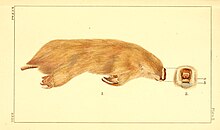| Southern marsupial mole[1] | |
|---|---|

| |
| Scientific classification | |
| Domain: | Eukaryota |
| Kingdom: | Animalia |
| Phylum: | Chordata |
| Class: | Mammalia |
| Infraclass: | Marsupialia |
| Order: | Notoryctemorphia |
| Family: | Notoryctidae |
| Genus: | Notoryctes |
| Species: | N. typhlops
|
| Binomial name | |
| Notoryctes typhlops Stirling, 1889.
| |

| |
| Southern marsupial mole range | |
The southern marsupial mole (Notoryctes typhlops), also known as the itjaritjari (pronounced [ˈɪɟɐrɪɟɐrɪ]) or itjari-itjari,[3][4] is a mole-like marsupial found in the western central deserts of Australia. It is extremely adapted to a burrowing way of life. It has large, shovel-like forepaws and silky fur, which helps it move easily. It also lacks complete eyes as it has little need for them. It feeds on earthworms and larvae.[5]
- ^ Groves, C. P. (2005). Wilson, D. E.; Reeder, D. M. (eds.). Mammal Species of the World: A Taxonomic and Geographic Reference (3rd ed.). Baltimore: Johns Hopkins University Press. p. 22. ISBN 0-801-88221-4. OCLC 62265494.
- ^ Burbidge, A.A.; Woinarski, J. (2016). "Notoryctes typhlops". IUCN Red List of Threatened Species. 2016: e.T14879A21965004. doi:10.2305/IUCN.UK.2016-1.RLTS.T14879A21965004.en. Retrieved 13 November 2021.
- ^ "Southern Marsupial Mole (Notoryctes typhlops)". Threatened species & ecological communities. Australian Government Department of the Environment and Energy. Retrieved 18 February 2019.
- ^ "Notoryctes typhlops — Itjaritjari, Southern Marsupial Mole, Yitjarritjarri". Species Profile and Threats Database. Australian Government Department of the Environment and Energy. Retrieved 18 February 2019.
- ^ Whitfield, Philip (1998). The Simon & Schuster Encyclopedia of Animals. New York: Marshall Editions Development Limited. p. 25.
